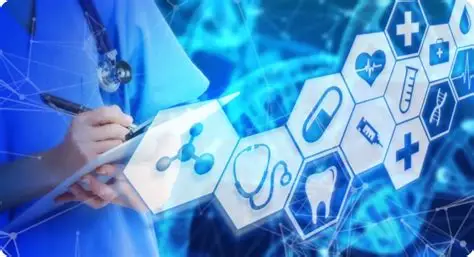The growing problem of health misinformation, as social media increasingly becomes an ‘accidental doctor
Medical information requires strict verification, yet in reality, the line between scientific knowledge and unsubstantiated advice is becoming increasingly blurred. Today, many people seek information about diseases, medications, or treatments from unofficial sources, including social media and online forums. The rapid but uncontrolled spread of such content has led to a rise in medical misunderstandings, causing individuals to self-treat incorrectly and miss the critical timing for proper medical intervention.
The consequences extend beyond individual health, eroding public trust in the healthcare system. The World Health Organization (WHO) refers to this phenomenon as an ‘infodemic’ — a pandemic of misinformation, posing a major challenge to modern medicine and an urgent issue for Vietnam’s healthcare sector amid its digital transformation.

The Benefits and Risks of Medical Information in the Digital Age
As health misinformation becomes increasingly widespread online, access to authoritative medical knowledge is more essential than ever. With just a few search actions, individuals can find hundreds of articles on diseases, medications, and nutrition. This proactive approach to learning helps communities enhance their awareness and engage more actively in managing their own health.
However, as social media becomes a common source of information, the downside of rapid dissemination has also become evident. Not all medical content online is verified; unproven ‘home remedies’ and anecdotal health tips often spread faster than scientific information. For Vietnam, this presents a significant challenge in the journey toward digital health transformation and the creation of a safe, transparent health information environment.
When ‘Dr. Google’ Takes Over
Health Information-Seeking Habits of Vietnamese People
In Vietnam, searching for health information on the Internet has become a familiar part of daily life. When unusual symptoms appear, many people immediately turn to Google or read articles on health blogs and forums to assess their condition on their own. Online community groups — especially on Facebook — have also become spaces where individuals exchange treatment experiences and share rapidly circulating ‘folk remedies.
This behavior is common across most age groups, yet the patterns differ noticeably. Younger individuals tend to trust technology websites or short explanatory videos on TikTok and YouTube; middle-aged users prefer community groups focused on chronic conditions; while older adults often rely on word-of-mouth advice or unverified online sources. This habit of ‘search first – consult later’ has inadvertently contributed to the widespread circulation of health misinformation within the community.
Psychological and Cultural Factors Behind Health Misinformation Belief
The tendency to believe health misinformation does not stem solely from a lack of medical knowledge, but also from deeper psychological and cultural factors. In many Asian cultures, including Vietnam, the mindset of ‘it’s better to try than to ignore’ makes individuals more susceptible to so-called ‘natural’ or ‘safe’ remedies, even when they have never been scientifically validated. When a post is shared thousands of times or recommended by acquaintances, the effect of social conformity further reinforces its perceived credibility in the eyes of the reader.

From a community psychology perspective, this is the result of limited basic medical knowledge combined with concerns about healthcare costs. Without regular guidance from physicians or specialists, individuals are more likely to seek alternative solutions on the Internet. This creates a dangerous cycle: the more they worry, the more they search; the more they search, the more misinformation they encounter — ultimately leading to improper self-treatment and eroding both personal health and trust in the formal healthcare system.
The Consequences of Health Misinformation for Public Health
Risks to Individuals
Health misinformation can lead individuals to make dangerous treatment decisions without recognizing the risks. Many people self-medicate based on online advice, using inappropriate dosages or applying unverified ‘folk’ remedies. When symptoms fail to improve, they eventually seek medical care — but by then, the condition may have progressed to a more severe stage, making treatment far more complex and costly
There have been numerous cases of severe complications, and even deaths, resulting from individuals placing absolute trust in ‘advice’ shared on the Internet. Beyond the direct health consequences, the deeper impact lies in the erosion of trust in the formal healthcare system. When people are repeatedly exposed to conflicting sources of information, they become more skeptical of evidence-based medical guidance, creating a widening gap between doctors and patients — a significant barrier to the goal of universal, effective healthcare.
Burden on the Healthcare System
From a systemic perspective, the spread of health misinformation places a significant burden on the healthcare sector. Medical facilities frequently receive patients who are hospitalized late due to incorrect self-treatment or worsening conditions caused by misguided remedies. This not only increases healthcare costs but also consumes hospital resources, reducing overall service capacity.
Healthcare professionals must spend additional time addressing the consequences of ‘word-of-mouth treatments’ and correcting patients’ misunderstandings with evidence-based medical procedures. Meanwhile, health authorities and public health communicators face a new challenge: restoring public trust and managing the flow of information. Medical misinformation not only causes economic losses but also slows the digital transformation of the healthcare sector, as standardized data and knowledge risk being ‘distorted’ by unverified sources.
Medical Verification and the Responsibility of Information Sharing
A Clear Mechanism for Verifying Medical Information Is Needed
In the digital environment, where anyone can share health-related content, establishing a reliable medical verification mechanism is essential. Regulatory bodies such as the Ministry of Health, professional councils, and medical journalism systems must play a central role in verifying, validating, and disseminating authoritative information. With clear verification procedures in place, the public can identify recognized data sources, and media outlets have a professional basis to consult before publication.
Globally, the concept of ‘medical fact-checking’ has become an important branch of health communication. Many international health organizations have established dedicated teams to review and respond to misinformation, particularly during the pandemic. This model not only helps prevent the spread of false information but also strengthens evidence-based health communication — a prerequisite for building public trust.
Applying Technology and Artificial Intelligence in Detecting Misinformation
Technology, particularly artificial intelligence (AI), is opening new approaches to detecting and preventing health misinformation. AI models can analyze linguistic structures, assess source credibility, and compare content with standardized medical guidelines from the World Health Organization (WHO) or national regulatory bodies. With the ability to process large datasets and learn contextual patterns, AI systems can quickly identify signs of misinformation, issue alerts, or automatically label content as ‘unverified’ for readers.
Several international projects are adopting this approach. WHO and Google Health have collaborated to develop an AI platform for global medical fact-checking, particularly in epidemiology and disease prevention. Similarly, research institutes in Europe and the U.S. are testing AI tools that assess the credibility of health articles using retrieval-augmented generation (RAG) algorithms. These models demonstrate that AI can become a valuable aid in promoting transparent medical communication — provided it operates under ethical principles, with controlled processes and oversight by qualified healthcare professionals.
The Role of Communities and Individuals in Combating Health Misinformation
Preventing misinformation is not solely the responsibility of regulatory authorities; it begins with the awareness of each Internet user. Every share or comment about health can influence others’ behavior. Verifying sources, consulting only content validated by physicians or health authorities, and avoiding the spread of unverified ‘remedies’ are simple yet effective ways to protect oneself and the community
Healthcare communities, the media, and educational institutions need to work together to cultivate a culture of selective engagement with medical information. Regularly implemented health communication programs can help people distinguish between medical knowledge and advertising, as well as between professional guidance and unsubstantiated advice. When knowledge is disseminated appropriately, medical information becomes a true tool for raising awareness rather than a source of confusion or misinformation.
Towards a Safe and Transparent Health Information Environment
Addressing the issue of health misinformation is not solely the responsibility of the healthcare sector; it is also a journey toward building trust and scientific literacy in the digital society. The spread of misinformation, whether intentional or accidental, can have serious consequences if not properly verified and guided. Creating a safe health information environment requires coordination among regulatory authorities, professionals, technology, and the awareness of each individual.
When individuals selectively share information responsibly, when evidence-based medical communication becomes the standard, and when technology is applied to verify rather than amplify misinformation, the healthcare sector will truly enter a new phase — one where knowledge is protected, trust is reinforced, and public health is placed at the center of every action


